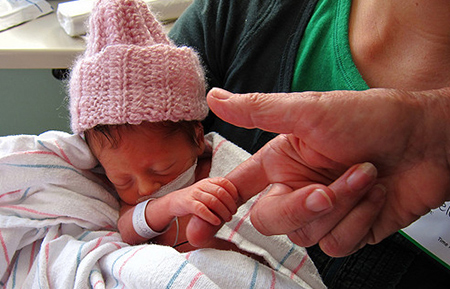Partnering for Success: Heard Takes Low-Birthweight Initiative Beyond County Lines
Print This Post
BY DIANA ST. LIFER
Heard may have the smallest population of the four counties participating in Georgia Family Connection’s Low-Birthweight (LBW) cohort, but everyone involved is big on ideas on how to best serve pregnant and parenting women.

The challenge is resources for the 301-square-mile county that 11,600 residents call home. With no hospital or obstetrician located within Heard, expectant mothers must travel beyond county lines for prenatal care and delivery. The only place for any type of prenatal information in the county is the health department. So Mandy Hill, coordinator of the LBW initiative in Heard, started there.
“We provide information about proper nutrition and the risks of smoking while pregnant, as well as the importance of waiting between pregnancies, especially if someone had a LBW baby before,” Hill explained, adding that 10 LBW babies were born in Heard in 2011. Women who come in for services receive additional information from the nurse and from educational videos that play on a continuous loop on the department’s waiting area television. “It’s a big drawback not having an obstetrician in the county,” Hill said.
Angie Nutt, nurse manager at the Heard County Health Dept., agrees. As the only registered nurse in the department, she knows demand is high and resources are low. The health department used to conduct home visits with at-risk mothers, but Heard County Community Partnership—the Georgia Family Connection Collaborative—has taken on that task.
By the Numbers
|
Because the WIC (Women, Infants and Children) program is no longer located within the health department, we don’t have direct access to mothers on WIC. But WIC still is a partner,” Nutt said.
These challenges, however, inspire resourcefulness. By partnering with other social and healthcare agencies, both Nutt and Hill are working to reduce the number of LBW babies in the county through a variety of collaborative programs and resources. One of those programs is providing obstetricians and gynecologists in Carrollton, Newnan, and LaGrange with informational packets for their patients.
“Since the initiative is multi-county, it’s about reaching residents beyond Heard County,” Hill said. “Now doctors can have the information available to all their patients.”
While a majority of funding for the LBW initiative comes from Kaiser Permanente, the Family Connection Collaboratives in the cohort are looking to community resources to support additional programs. For example, funding for the extra materials for the doctors’ offices comes from Tanner Health System, which has become a valuable partner to Heard in the LBW initiative. Through its own Get Healthy, Live Well initiative, Tanner provides programs and services that promote healthier lifestyles in several counties, including Heard. The initiative is funded by a Community Transformation Grant from the Centers for Disease Control and Prevention. The Carrollton-based medical center also recently opened a family clinic in Franklin.
“We’re working closely with the Heard County Collaborative to make them aware of our programs and to get initiatives going in the community,” said Kelly Bainbridge, community health project coordinator for Get Healthy, Live Well. “We’re bringing everyone together to look at the pressing issues around low birthweight in Heard and how we can leverage our community partnerships to bring more resources and programs directly into the county.”
Another advantage to the partnership with Tanner is that the Heard LBW initiative can be tied to the Get Healthy, Live Well media and public awareness campaign. “We’re in the process of developing a large-scale media campaign that would have a regional outreach,” Bainbridge said. “We want to help Heard County reach its goals within our campaign. By working with us, the Low Birthweight initiative can gain access to a lot of people and programmatic resources.”
Heard’s LBW rate is lower than the other counties in the cohort and lower than the state average. It does, however, contend with other challenging factors. “We have a high rate of pregnant smokers, a high rate of obesity among pregnant women, and the nutrition among this population is not the best,” Hill said. “In addition, our teen birth rate is significant for a county our size. So we have a lot of risk factors associated with low birthweight babies.”
To address these factors, Heard developed additional partnerships to bring services into the county, including West Georgia Health to offer smoking cessation classes at the community building, and Twin Cedars Youth and Family Services to provide Circle of Care, a secondary teen pregnancy program.

“Teenagers are more likely to have a low birthweight baby, so it’s really important that we share information with them as well,” said Hill. “That’s why the initiative has a presence where so many teens get their information—Facebook.”
Circle of Care works with pregnant and parenting teens—and their families—to address the rising teen pregnancy rate, which, Hill says, matches the national average of 25 percent. “The main goal is for these girls to not have another baby within two years, or not have another unplanned pregnancy in the foreseeable future,” she said.
Dedtria Jackson, coordinator for the Circle of Care program, says the indicators of child and family well-being are all connected, and one will always drive another.
“If you engage in one risky behavior, like underage drinking or drug use, it’s going to lead to other risky behavior, such as sexual contact,” said Jackson. “That can lead to pregnancy, which in turn will ultimately have an impact on the low birthweight and teen high-school dropout rates.”
Diana St. Lifer is a professional writer with more than 25 years’ experience. She holds a bachelor’s degree in communications, a post-B.A. certificate in child advocacy, and is a certified professional life coach who specializes in teen and adolescent issues.
The Twin Cedars Circle of Care program has two primary goals: To prevent teen mothers from having another unplanned pregnancy and to encourage them to return to high school to earn a diploma or GED.
Read “Circle of Care Embraces Heard’s Youngest Parents.”
Low birthweight, childhood obesity, and a literacy gap are serious threats to the well-being of Georgia’s families and children. Recognizing the impact these pressing issues have on the state’s health, safety, and ability to prosper, Georgia Family Connection Partnership has launched three initiatives dedicated to developing and implementing strategies that address these key indicators.
Read “Eleven Family Connection Collaboratives Team Up to Tackle Key Indicators of Child and Family Well-Being.”
